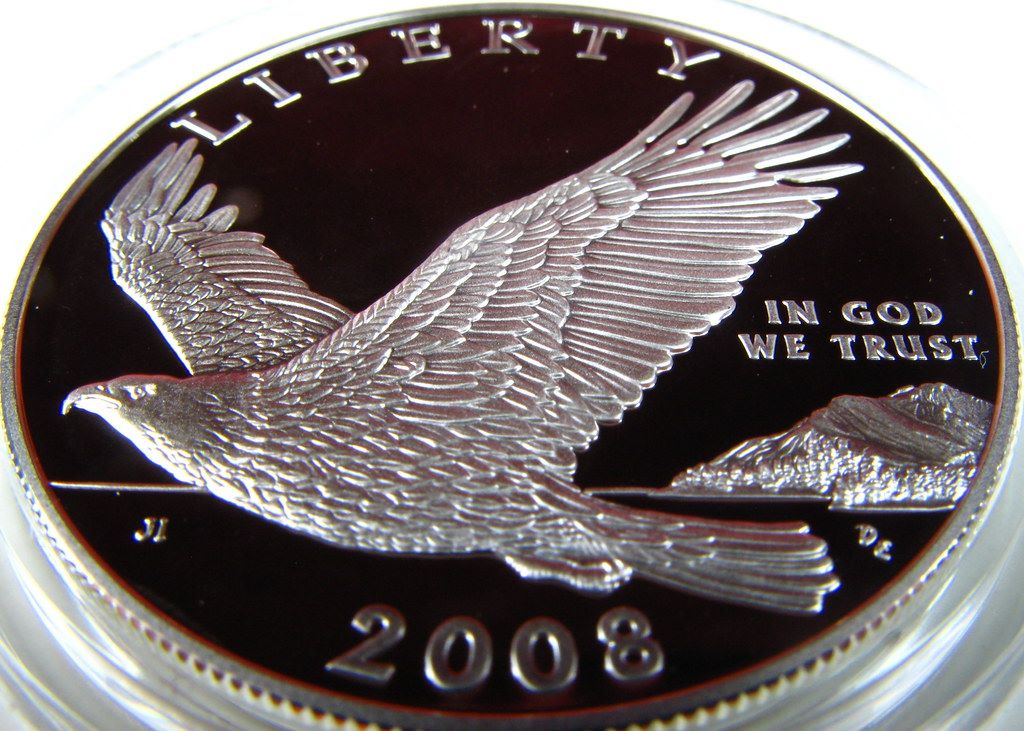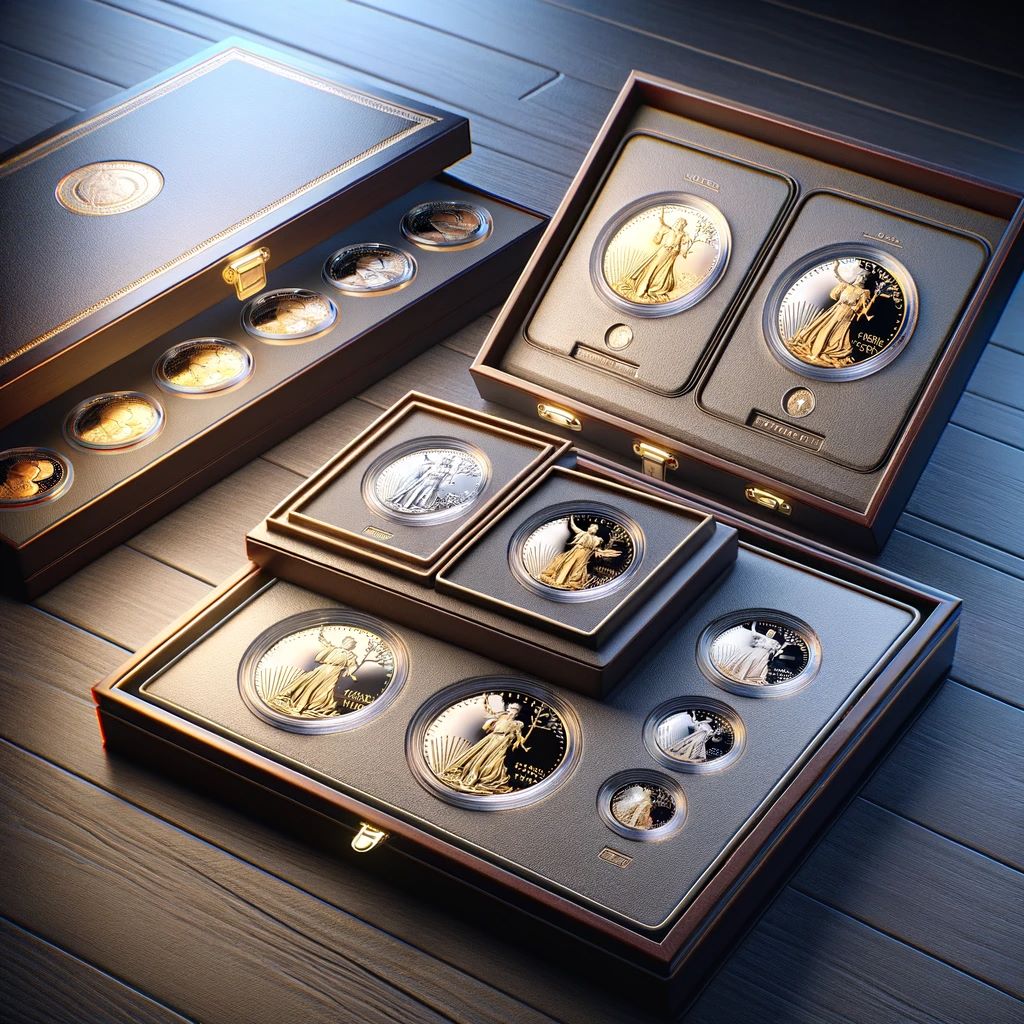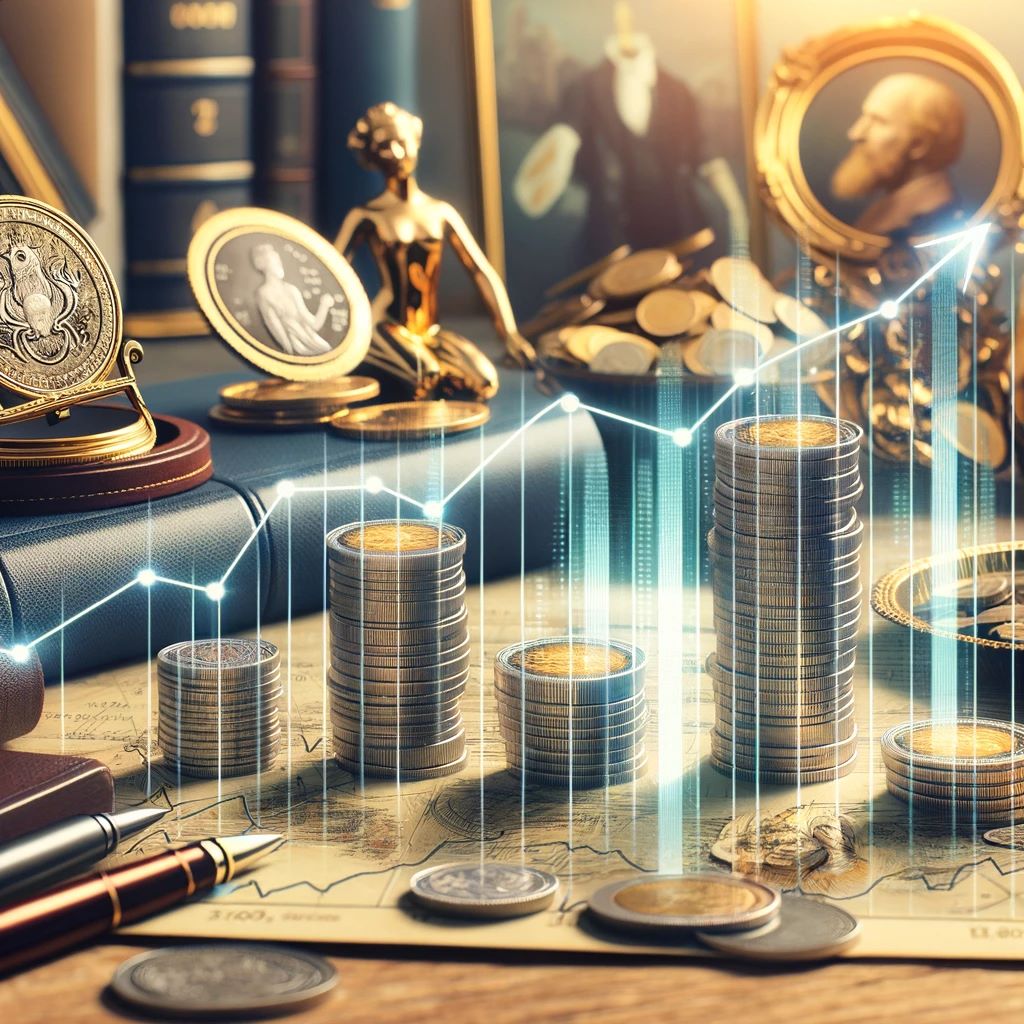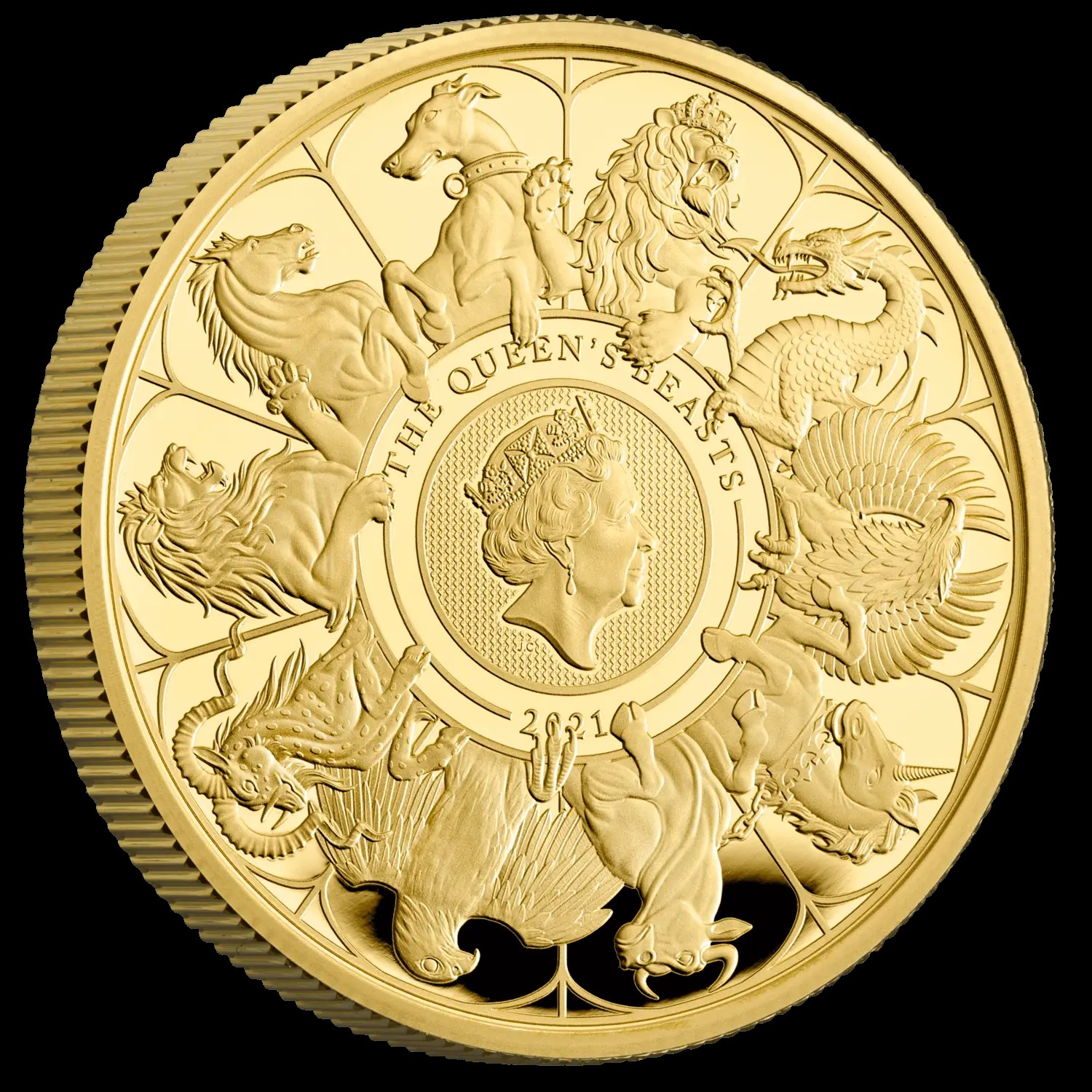What is a Proof Coin?
04/01/2024Daniel Fisher
Free & fully insured UK Delivery. Learn more
Secure & flexible payments. Learn more

Buyback Guarantee Learn more
Proof coins are crafted with precision, artistry, and a touch of exclusivity. It is often said that investors are best buying bullion coins, so that they may maximise the value of gold for the price they pay. Likewise, collectors tend to favour proof versions of coins for their aesthetics. But is it as simple as that?
Choosing the right coin finish can have a significant impact on value and appeal. We explore what a proof coin is, the minting process, why they are highly valued, and compare them to both Brilliant Uncirculated and bullion coins.
Proof coins are special editions, meticulously crafted to showcase exceptional quality. Unlike regular circulation coins, proof coins are struck using a highly polished die and planchet, resulting in a mirror-like surface. These coins stand out with sharp details, frosted engravings, and distinctive finishes, making them visually appealing and collectable.
The history of proof coins dates back to the early days of mintage. Originally, proofs were struck to verify the quality and accuracy of dies or showcase a mint’s capabilities. A proof coin is produced when launching a coin to secure approvals from important authorities like the Ministry of finance, the Chancellor of the Exchequer and the Directors of the Mint. Over time, they evolved into collectible pieces, with mints producing limited quantities for enthusiasts and collectors.
It’s crucial to differentiate between standard coins which constitute the majority of a mint’s production run and the refined beauty of proof coins. While regular coins are mass-produced, proof coins are crafted with precision, limited in quantity, and designed to showcase the highest standards of minting. This distinction elevates proof coins to a status beyond mere currency or investment.
Many gold and silver coins are not only produced to proof quality, but also in Brilliant Uncirculated (BU) and Bullion too. So what features do proof coins have that makes them easily distinguishable from the other varieties? How can you tell if your coin is proof or not?

Proof coins boast polished and reflective surfaces that set them apart from everyday currency and standard gold or silver coins. This mirror-like quality is achieved through a meticulous minting process. Highly polished dies and planchets are used, resulting in a flawless, reflective finish. Combining matt or frosted sections like a monarch’s portrait (known as the device) with polished areas such as the background (known as the field), proof coin imagery feels far more 3-dimensional. These finishes add an artistic element to the coins, enhancing their visual appeal. The contrast between the frosted and mirrored areas creates a striking effect that makes proof coins stand out.
Proof coins go beyond standard strikes; they exhibit a level of precision and detail in their design that sets them apart. The engraving on proof coins is a testament to the craftsmanship involved in their creation. Sharp strikes bring out intricate details, ensuring that each element of the coin’s design is crisply defined. Comparing detail of elements like hair strands on a monarch between proof and standard coins may reveal the enhancement. We sometimes compare the sharpness of proof coins with Ultra High-Definition TV versus Standard Definition TV.
Proof coins are deliberately produced in limited quantities. This intentional scarcity contributes significantly to their collectible value. The limited mintage adds an element of exclusivity, making each proof coin a coveted piece among collectors.
To ensure the preservation of their pristine condition and collectible value, proof coins come in elegant and protective packaging. The presentation boxes are more than just a means of aesthetic appeal; they play a crucial role in safeguarding the coin’s condition and value over time.
Many of the world’s most popular gold and silver coins are produced in three different types of coin finish. In essence, each version may weigh the same, share identical obverse and reverse designs and contain equal amounts of precious metals. So why are there different versions, why do they not cost the same and which is most suitable to buy?
When comparing proof, bullion, and Brilliant Uncirculated (BU) coins, one noticeable distinction lies in the sharpness of details and clarity of images. Proof coins, crafted with meticulous precision, exhibit unparalleled clarity in the engraving. The fine details of the design are crisp and well-defined, making each element stand out. In contrast, bullion coins, produced primarily for investment purposes, may display slightly less detailed images. BU coins, falling between the proof and bullion categories, strike a balance, offering clear details without the meticulous precision of proofs.
Another aspect to consider is the shine, brilliance, and reflectivity of the coins. Proof coins, with their mirror-like surfaces, boast a distinctive shine that sets them apart. The brilliance of the design, enhanced by carefully crafted finishes, adds a captivating allure. Bullion coins, while still lustrous, may not achieve the same level of brilliance as proofs. BU coins, with a focus on maintaining a pristine appearance, claim the middle ground, exhibiting a respectable shine without the mirror-like quality found in proofs. Most buyers are impressed and satisfied with the mint finish of bullion coins and may not seek the incremental improvements of the enhanced versions.

The protective packaging used for each type of coin also contributes to their appearance and preservation. Proof coins, being the more delicate and collectible of the three, often come in elegant and secure packaging. Coins will generally be encapsulated in a plastic coin capsule which then sits in a wood or leather-bound presentation box. It’s common for coin details and certification to accompany the coin itself, confirming facts such as metal content and mintage numbers. This makes proof coins a preferred choice as gifts, especially representing certain occasions. This packaging not only enhances the presentation but also shields the coin from environmental elements that could affect its condition.
Bullion coins, designed primarily for investment and trade, typically have minimal packaging. Individual coins may be received in simple plastic grip-seal bags, while larger quantities usually arrive in plastic coins tubes holding 10-25 coins. This simplicity supports the drive to keep costs low. BU coins, falling between the two, may have protective packaging, but it is generally less ornate compared to that of proof coins
Understanding the manufacturing methods is essential when comparing proof, bullion, and Brilliant Uncirculated (BU) coins. Proof coins undergo a meticulous process involving highly polished dies and planchets. The striking process is deliberate, emphasizing precision to achieve mirror-like surfaces and sharp details. Bullion coins, on the other hand, are typically mass-produced using standard dies and planchets, focusing more on efficiency for investment purposes. BU coins fall in between, featuring a level of detail closer to proofs but without the same precision.

Quality control is a critical aspect of coin production. Proofs, being collectibles, undergo stringent inspection and adhere to high-quality standards. Mints allow minimal flaws, and any imperfections can significantly impact the coin’s value. Bullion coins, while still meeting quality standards, may have a higher tolerance for flaws, given their primary purpose for investment. A degree of production variance on new bullion coins is accepted with prices being based mostly on precious metals content rather than scarcity or design. In fact, many precious metals enthusiasts embrace the modest variations of bullion coins as opposed to the sterile and predictable flawlessness of proof coins. BU coins are subject to quality control measures, with a balance between precision and efficiency in mind, allowing for a moderate level of imperfections.
One key consideration when comparing proof, bullion, and Brilliant Uncirculated (BU) coins is the premium cost associated with proofs. Proof coins often command a higher price due to their collector appeal and limited mintage. Prices can be inflated by up to 30% when compared to ‘identical’ bullion versions and far higher if the proof coin is exclusive made in this finish only. This premium is not solely based on the intrinsic metal value but also on the craftsmanship, exclusivity, and potential appreciation over time.
Bullion coins, in contrast, are primarily priced based on the metal content. Their value is more closely tied to the current market prices of metals like gold or silver. Their price will incorporate production costs, delivery and dealer margins. Clearly the buying price of an asset plays a major role when investing, so the significant difference between proof and bullion premiums tends to be a critical factor in deciding which is most suitable.
BU coins, falling between the two, carry a moderate premium, reflecting a balance between collectibility and metal value.
The resale dynamics of bullion and proof coins differ significantly. Bullion coins are known for their stability in pricing, closely tracking the current market value of the metals they contain. These coins are often sought after by investors looking for a reliable store of value. On the other hand, proof coins may exhibit a potential for appreciation over time, driven by their limited mintage, collector demand, and historical significance. Collectors are often willing to pay premiums for rare proofs, contributing to their potential appreciation. However it’s important to understand that value of proof coins can be subjective. Buying an exclusive coin at a significant premium doesn’t guarantee you’ll be able to sell at the same or higher. BU coins, being a hybrid of sorts, can offer a compromise, providing a degree of stability while carrying some potential for appreciation.
Free ultimate guide for keen gold investors
Understanding the purpose behind proof, bullion, and Brilliant Uncirculated (BU) coins is essential in determining their value. Decide on your objectives and priorities first before diving into buying gold or silver coins.
Proof coins are meticulously crafted with collectors in mind and it may be worth considering getting yours graded to verify its condition. These coins prioritize aesthetic appeal, intricate details, and limited mintage, making them sought after by collectors who appreciate the artistry and exclusivity. Bullion coins, however, serve a different purpose – they are primarily produced for investors looking to acquire precious metals. The value of bullion coins is closely tied to the metal content, providing a tangible asset for those focusing on wealth preservation. BU coins, positioned between proofs and bullion, cater to both collectors and investors, but essentially can be not fully appeal to either end of the spectrum.
Rarity plays a crucial role in determining the value and desirability of coins. Proof coins, with their limited mintage and emphasis on exclusivity, are inherently rare. Their scarcity is intentional, contributing to their collector value. Bullion coins, while produced in higher quantities to meet investment demand, may still hold value due to the inherent rarity of precious metals.
Many of the major global mints also produce range of bullion finish coins in limited mintage numbers or for a limited time period only. A great example is the Royal Mint Queen’s Beasts gold and silver coins. Premiums were only marginally higher than mass-produced coins due to the basic bullion production. But each coin in the set of eleven was only minted for 6 months. This limitation has led to premiums rising significantly over time, without the upfront risk of paying proof-level prices.
If you’re considering buying gold or silver coins with the emphasis on investment, are proof coins a good option?

When considering investment suitability, it’s essential to weigh the reward potential of bullion against the higher risk and reward associated with proof coin collecting. Bullion coins, with their stability tied to the intrinsic value of precious metals, offer a reliable and tangible store of value. The focus here is on wealth preservation and a steady, predictable investment. Undoubtedly, investors seeking to purchase gold or silver coins in any reasonable quantity are usually better off sticking with bullion coins.
On the other hand, proof coin collecting introduces a higher risk and reward dynamic. The potential for significant appreciation exists due to factors like limited mintage, collector demand, and historical significance. However, this potential comes with the risk of market fluctuations and the unpredictability of collector preferences. A higher degree of research and market knowledge is required to make good returns with proof coins. Many proof buyers prioritize the enjoyment they get from the coin’s aesthetics over pure profit making.
Understanding the collector community and the desirability that drives proof coin prices is crucial for evaluating investment suitability. Proof coins derive significant value from collector demand, which can be fickle. The numismatic community, characterized by enthusiasts and collectors, plays a pivotal role in driving the prices of proof coins. The desirability of these coins stems from their limited mintage, artistic appeal, and historical significance. Collectors often seek to complete sets or acquire rare proofs, driving demand and, subsequently, prices.
Bullion coins, while having intrinsic value and investment appeal, lack the same general level of desirability within the collector community. But as previously stated, renowned global mints are increasingly recognizing the commercial potential of producing collectable series of bullion coins, bridging the gap between mass-produced and highly collectable.
Several renowned proof coin series from various mints captivate collectors and enthusiasts alike. These series often go beyond individual coins, offering multi-coin proof sets that tell compelling stories through their designs. These series, often presented as multi-coin proof sets, have become iconic among collectors. Here are some noteworthy examples:

The Queen’s Beasts Series by the Royal Mint, initiated in 2016, is a collection of regal proof coins honoring the historic symbols of the United Kingdom. Inspired by the ten heraldic beasts present at Queen Elizabeth II’s 1953 coronation, each coin in the series showcases a detailed representation of one of these mythical creatures. From the Lion of England to the Griffin and the Unicorn, the series exemplifies the Royal Mint’s precision in capturing the essence of British heritage and the coins are recognised for their engaging and detailed design. A special 11th ‘Completer’ coin summarizes all ten beasts. The success and popularity of this series led to the subsequent launch of the Tudor Beasts series.
The America the Beautiful Quarters Series, an initiative by the United States Mint, showcases the nation’s stunning natural wonders through a collection of meticulously crafted proof coins. This series, launched in 2010, features five new designs each year, each representing a different national park or historical site. The proof coins, made from silver, capture the intricate details of iconic landmarks, such as Yellowstone National Park, the Grand Canyon, and Acadia National Park. The series not only celebrates the beauty of the United States but also offers collectors a unique opportunity to assemble a visual journey through the country’s diverse landscapes.
The Lunar Series, produced by the Perth Mint, is a captivating collection that aligns with the Chinese zodiac’s rotating animal symbols. Launched in 1996, each year is dedicated to a specific animal, following the twelve-year cycle of the zodiac. Its global success held particular appeal in the close-by Asian market due to its Chinese theme and no doubt led to the Royal Mint launching their own Lunar series version in 2014.
The proof coins in this series feature exquisite designs, incorporating cultural symbolism associated with each animal. From the noble Dragon to the wise and elusive Rat, the Lunar Series captures the essence of the Chinese zodiac through its detailed craftsmanship. This thematic approach not only appeals to collectors interested in astrology but also adds a layer of cultural significance to the world of numismatics, making each Lunar Series release highly anticipated and sought after.
Proof coins have evolved from simply being a testing precursor to a new bullion production run into an exciting niche product in its own right. Their stunning appearance and exclusivity appeal to a growing fanbase of collectors, but their inflated prices are perhaps less suitable for serious investors.
Our automated portfolio builder will provide suggestions based on various investment objectives.
A Proof coin is a specially minted coin with sharper imagery and detail, issued in far smaller numbers than mass-produced bullion coins. Historically global mints have used proof coins to test the dies before embarking on a major new bullion coin production but they’ve now evolved into appealing to collectors seeking their enhanced aesthetic appeal and exclusivity.
Proof coins are crafted through a meticulous minting process. Specially polished dies and planchets are used to create a flawless, reflective finish, and the striking process emphasizes precision for sharp details.
Proof coins stand out with their combined use of frosted and mirrored sections, creating more 3-dimensional images than standard circulation coins. They are crafted for collectors and sold in beautiful presentation boxes, emphasizing aesthetics and limited mintage.
The higher price of Proof coins is due to both higher production costs and collector’s premiums. This cost comprises their more complicated minting process than bullion coins, inclusion of costly presentation boxes and certificates, and the additional premium collectors will pay for their enhanced looks and limited mintage.
Generally Proof coins are better suited to collectors, with bullion coins offering investors lower premiums. They can prove to be a good investment for expert collectors who are able to research the market and find keen buyers to pay enhanced prices for limited mintage coins when it comes to selling.
A reverse proof coin is a variant where the raised design elements are mirrored, and the background is frosted, creating a striking visual contrast. Popular for their unique aesthetics, reverse proofs offer collectors a distinct version of traditional proof coins.
Images: Flickr and Matthew Heinrichs
Live Gold Spot Price in Sterling. Gold is one of the densest of all metals. It is a good conductor of heat and electricity. It is also soft and the most malleable and ductile of the elements; an ounce (31.1 grams; gold is weighed in troy ounces) can be beaten out to 187 square feet (about 17 square metres) in extremely thin sheets called gold leaf.
Live Silver Spot Price in Sterling. Silver (Ag), chemical element, a white lustrous metal valued for its decorative beauty and electrical conductivity. Silver is located in Group 11 (Ib) and Period 5 of the periodic table, between copper (Period 4) and gold (Period 6), and its physical and chemical properties are intermediate between those two metals.